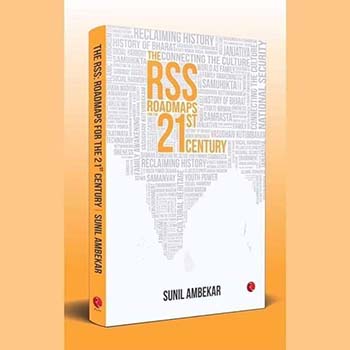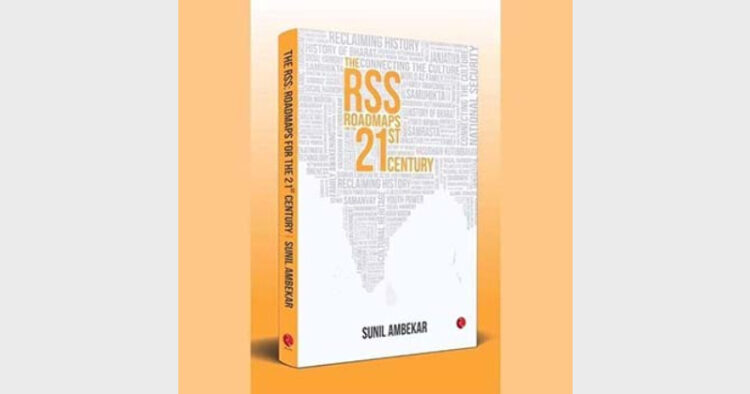
The RSS: Roadmaps for the 21 Century
Author : Sunil Ambekar, Published by Rupa Publications India Pvt. Ltd, Hardcover,
Pages: 230, Price: Rs 495
Pages: 230, Price: Rs 495
To understand the internal structure and processes of the RSS and get perspectives on larger national issues, this book can be an interesting starting point and ready reckoner. For a researcher like me, whose primary language of thought and expression is English, this book certainly opens a new window for decoding the mystery called RSS
Aayushi Ketkar
Doling out literature about Rashtriya Swayamsevak Sangh (RSS) is at an all-time high. It is natural, as the nationalist organisation is seen as ‘the’ power-centre by many, especially those observing it from outside. Even otherwise, as the largest voluntary organisation of the world, one cannot ignore this fact. From the RSS staple, there is plenty of material that keeps coming either in the form of official statements or reports and now even in the form of articles by senior office bearers on many contemporary issues. This is more out of need than desire; the need to dispel misconceptions, misperceptions built on malafide campaign of misinformation by vested interests wanting to break the country and deny its people their rich cultural heritage.
Still, there are many misperceptions and misconceptions about the organisation and its ideological position. The primary reason for this being the fact that it is only recently that RSS started communicating in English, which is the language of ‘elite intellectual class’. This is where the book ‘The RSS: Roadmaps for the 21st Century’ by Sunil Ambekar, the national organising secretary of Akhil Bharatiya Vidyarthi Parishad (ABVP), stands out. No wonder, the book launch at Ambedkar International Centre, New Delhi, was nothing short of a mega show, with the who’s who of the capital including many Union Ministers and noted movers and shakers from the Lutyens Zone, in attendance. Again, this is not the first book by an RSS Pracharak holding the national level position. Right from Guruji Golwakar, the second Sarsanghachalak of RSS to thinkers like Dattopant Thengadi and HV Seshadri, many have articulated their views on various occasions in English, explaining the Sangh’s position to the outside world. Even Pt Deendayal Upadhyaya, who mainly contributed through his articulation of Integral Humanism, gave a comprehensive vision of the Hindu Rashtra, as envisaged by the RSS. For many like me, who seek to understand the RSS as an objective researcher will find this book different on many fronts.
Firstly, though the author is primarily telling the RSS story, its origin, functioning including the elaborate consultative process and relevance for the 21st century, eloquently as a personalised experience. For instance, while explaining Shakha as a structure and the association of a swayamsevak with his Shakha, the author writes, “Every swayamsevak has a shakha to which he belongs. In my case, as a child growing up in Nagpur, I was part of the Mohite Shakha. …When I moved to Mumbai in 2003, Shivaji Udyan Prabhat became my Shakha’. Now sharing this personal experience is a unique way of writing a book that is fundamentally about an organisation, which believes not to put ‘I’ before ‘we’. This book is a marked detour from that archaic practice. However, the commendable part is, while doing so, Shri Sunil Ambekar has not put his story ahead of the RSS story but used his experiences to take the RSS story forward.
Secondly, explaining the philosophical position of an organisation is a difficult task. Many a times, it makes the narration dry and mundane, risking the loss of interest of the readers. The author has avoided this carefully and competently. Either on the topical issue of status of minorities or the contentious issue of caste, the author has brought clarity on all counts with the help of real-time incidents, rather than theoretical jargons or rhetoric. Here again, the reference of his childhood friends Cyril Pillai and Kaiser Yusuf is significant as not just words but action in social life that defines any organisation. Even the touchy issues, like Ram Janmabhoomi, Article 370 and Uniform Civil Code are dealt with precision giving suitable examples.
Thirdly, the book deals with many contemporary and future challenges, mostly untouched in the RSS literature until some consensus is built and official position articulated. For instance, ‘RSS in the Globalised World’ is completely a new area explored by the author. In this he states how our position vis-a-vis many countries like Pakistan or China is taken when there is a threat like situation, without any clear, consistent and coherent global footprint. The author has also candidly talked about the role of Pravasi Bharatiyas, the cultural influence of Bharat and global challenges like terrorism, radicalism, forced globalisation and reactions to it. Shri Ambekar explains what the Sangh has been doing through various platforms like Antar Rashtriya Sahayog Parishad in the political and academic arena. At the same time, the book gives indication about future possibilities and options for Bharat as envisioned by the RSS. The institution of family and the role of women is a critical part of this book highlighting the challenges thrown by the fast-changing social and economic order. For me, as a woman and mother, this is the most important part that provides a glimmer of hope in a largely dehumanised world. The starting of a separate vertical by the organisation to tackle environmental issues, with the aim of galvanising the society and bringing various individuals and organisations on a single platform for conservation; challenge of dealing with Global Capitalism and indigenous alternatives to the same; and the possibility of Bharat providing a ‘sustainable’ answer to the discourse on development, are some of the many new areas on which RSS is yet to take a futuristic stand.
The book certainly has the underpinnings of an emotional journey, seamlessly woven by the author who is essentially an activist and organiser. It is an interesting and intriguing blend of idealist-philosophical position and realist-experiential narrative. The usage of traditional Sangh terminologies with lucid explanation and candid clarification about Sangh-politics relationship can be a guiding force for many who are working with the organisation, nay movement. At the same time, this book can dispel many preconceived notions about the organisation and infuse curiosity to the extent of wanting a firsthand experience, a temptation difficult to resist. Citation of relevant primary references, which is not a trait of such genre, is another surprise element of this book.
A dedicated chapter on the author’s journey in the student’s movement (ABVP) and how Sangh or ABVP is handling the challenges of contemporary issues in the field of education could have been a great addition, considering the profile of the author. Some anecdotal pictures would have made it more enticing for the present generation. All in all, to understand the internal structure and processes and get perspectives on larger national issues, this book can be an interesting starting point and ready reckoner. For a researcher like me, whose primary language of thought and expression is English, this book certainly opens a new window for decoding the mystery called RSS.
(The reviewer is a faculty of Political Science at Gautam Buddha University, Greater NOIDA)













Comments